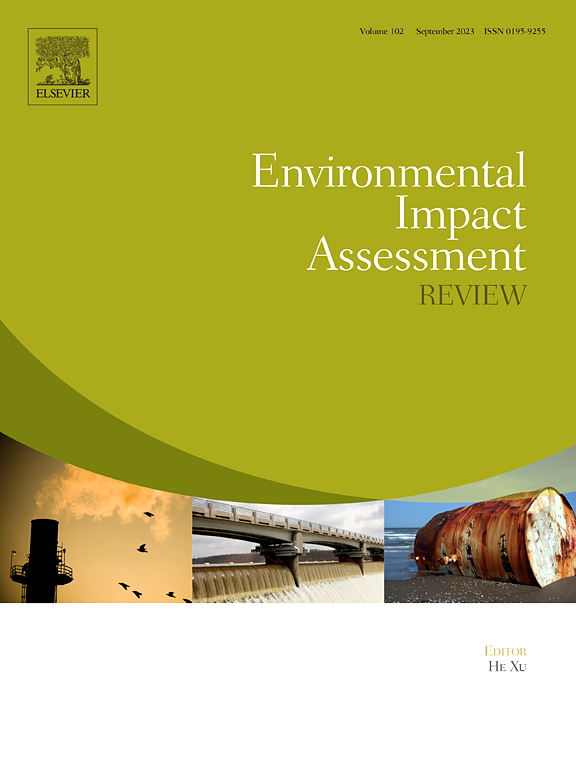农村人工湿地在形成水-陆-能-碳关系中的潜在作用
IF 9.8
1区 社会学
Q1 ENVIRONMENTAL STUDIES
引用次数: 0
摘要
将城市污水处理模式直接应用于农村地区往往导致成本增加和技术挑战,主要原因是缺乏对当地适应性和可持续性的考虑。人工湿地(CWs)作为一种更合适的替代方案,因其在解决农村地区污水处理方面的潜力而日益得到认可,形成了一个关键的水-陆-能-碳(WLEC)联系。尽管它们得到了推广,但对农村污水处理中的小型化粪池的系统分析和可持续性研究,特别是从WLEC关系的角度来看,仍然很少。本研究建立了一个基于生命周期评估和情景分析的方法框架,以评估农村生态系统的WLEC关系和潜在的环境可持续性。并将该方法框架应用于华中地区一个连续降水系统的实例研究。结果表明,与传统的废水处理方法相比,该方法节省了约90%的能源,减少了约一半的碳排放。虽然化学武器带来了许多好处,特别是在改善水质方面,但它们也对能源和土地产生了显著影响,这表明在WLEC关系中存在固有的权衡。这项研究确定了材料优化是一种直接而高效的减轻环境影响的策略,而水的再利用是实现效益最大化的关键因素。这些研究结果为农村污水的可持续管理提供了宝贵的见解,并提出了可行的解决办法,促进了关于农村环境和资源管理的更广泛讨论,特别是在发展中国家。本文章由计算机程序翻译,如有差异,请以英文原文为准。

Potential role of rural constructed wetlands in shaping water-land-energy‑carbon nexus
The direct application of urban sewage treatment models to rural areas often results in increased costs and technical challenges, primarily due to a lack of considerations for local adaptability and sustainability. Constructed wetlands (CWs), as a more suitable alternative, have been increasingly recognised for their potential in addressing sewage treatment in rural areas, forming a critical water–land–energy–carbon (WLEC) nexus. Despite their promotion, systematic analyses and sustainability research on small-scale CWs in rural wastewater treatment, particularly from a WLEC nexus perspective, remain scarce. This study established a methodology framework based on a life cycle assessment (LCA) and scenario analyses to evaluate the WLEC nexus of rural CW systems and potential environmental sustainability. The methodology framework was employed in a case study of a CW system in central China. The results highlighted significant energy savings of approximately 90 % and a reduction in carbon emissions of approximately half compared with traditional wastewater treatment. While CWs provide numerous benefits, particularly in enhancing water quality, they also had notable impacts on energy and land impacts, indicating inherent trade-offs within the WLEC nexus. This study identified material optimisation as a straightforward yet highly effective strategy for mitigating environmental impacts, with water reuse emerging as a key factor for maximising benefits. These findings provided valuable insights and propose actionable solutions for the sustainable management of rural sewage, contributing to the broader discourse on the environment and resource management in rural contexts, especially in developing countries.
求助全文
通过发布文献求助,成功后即可免费获取论文全文。
去求助
来源期刊

Environmental Impact Assessment Review
ENVIRONMENTAL STUDIES-
CiteScore
12.60
自引率
10.10%
发文量
200
审稿时长
33 days
期刊介绍:
Environmental Impact Assessment Review is an interdisciplinary journal that serves a global audience of practitioners, policymakers, and academics involved in assessing the environmental impact of policies, projects, processes, and products. The journal focuses on innovative theory and practice in environmental impact assessment (EIA). Papers are expected to present innovative ideas, be topical, and coherent. The journal emphasizes concepts, methods, techniques, approaches, and systems related to EIA theory and practice.
 求助内容:
求助内容: 应助结果提醒方式:
应助结果提醒方式:


